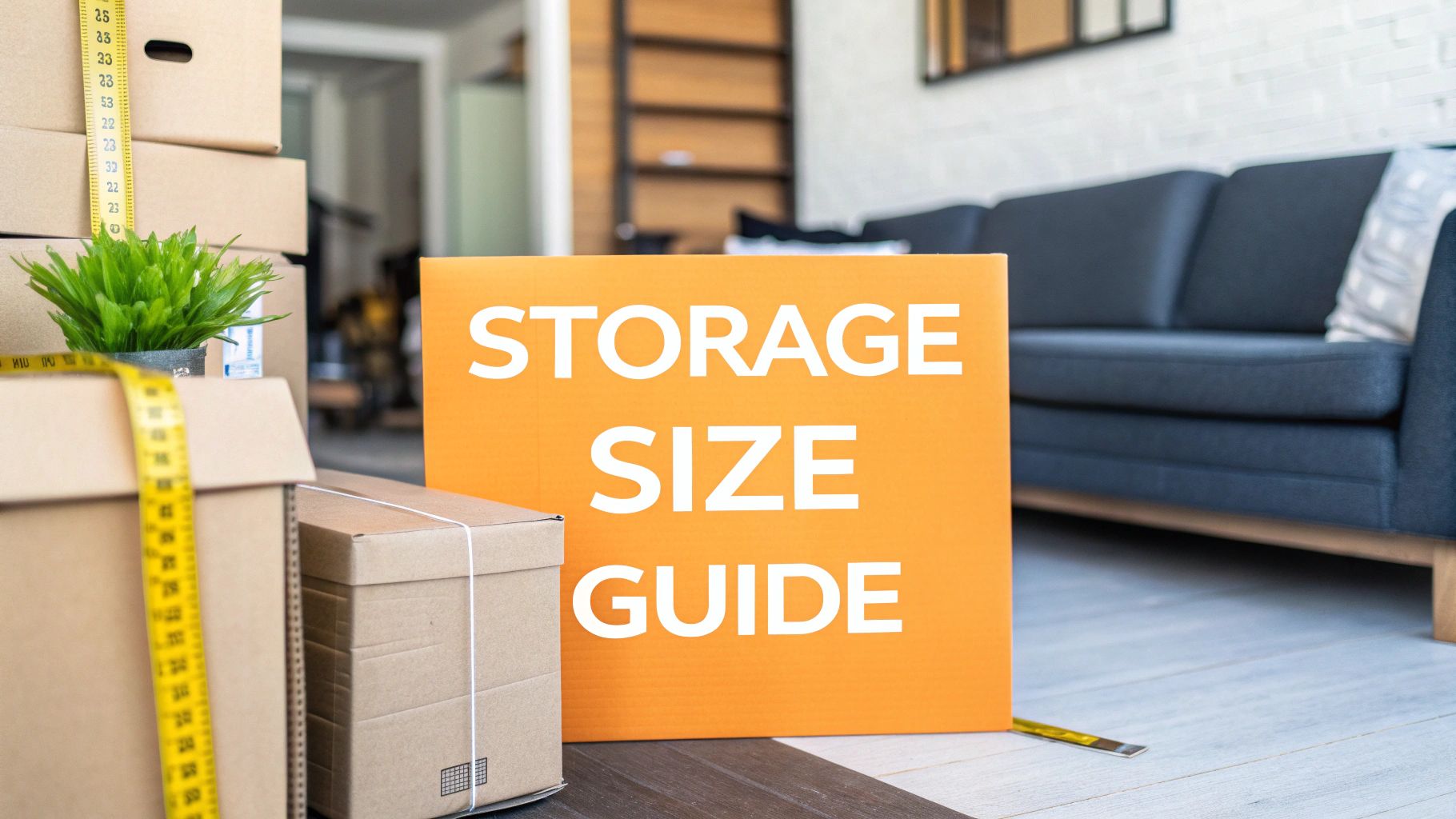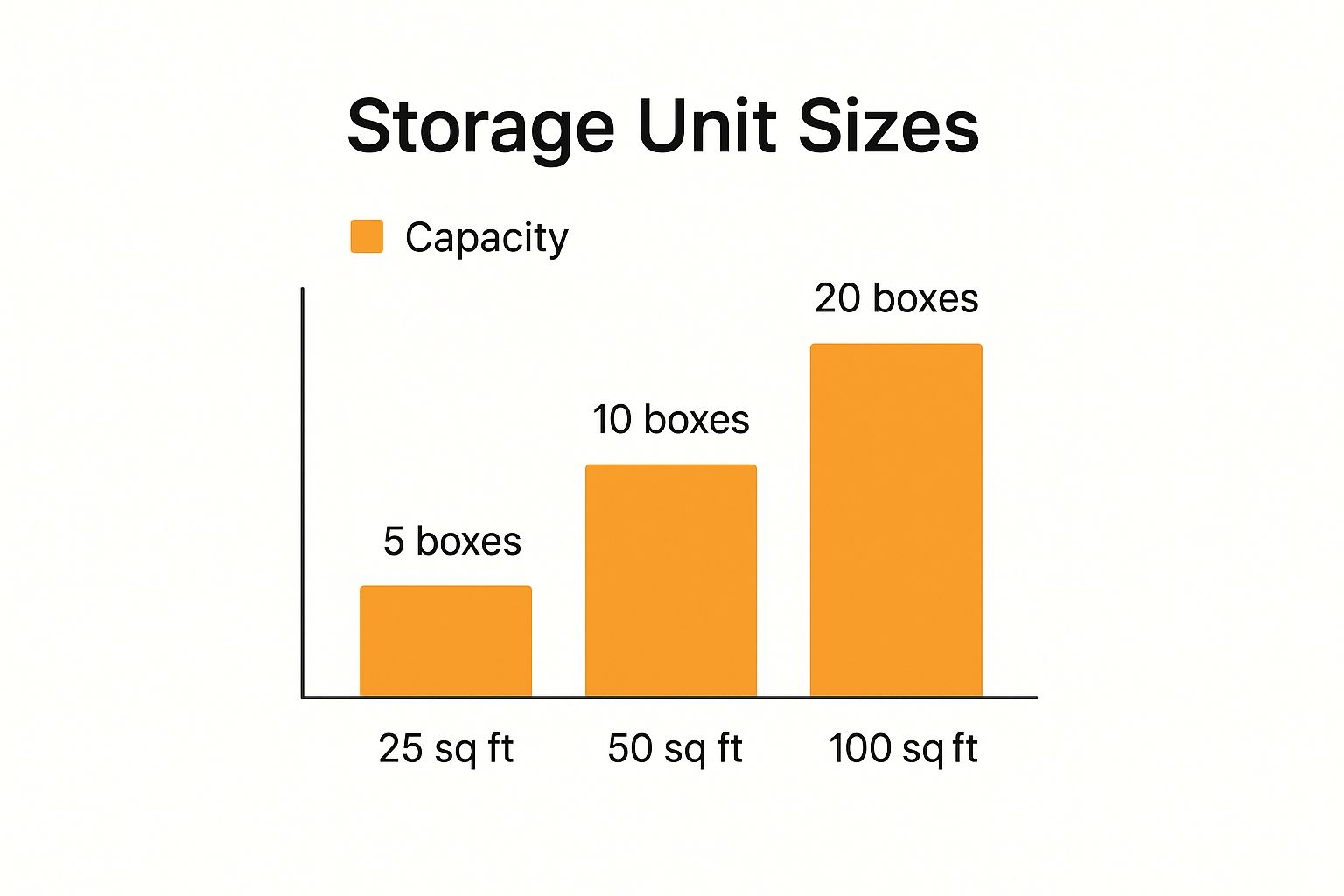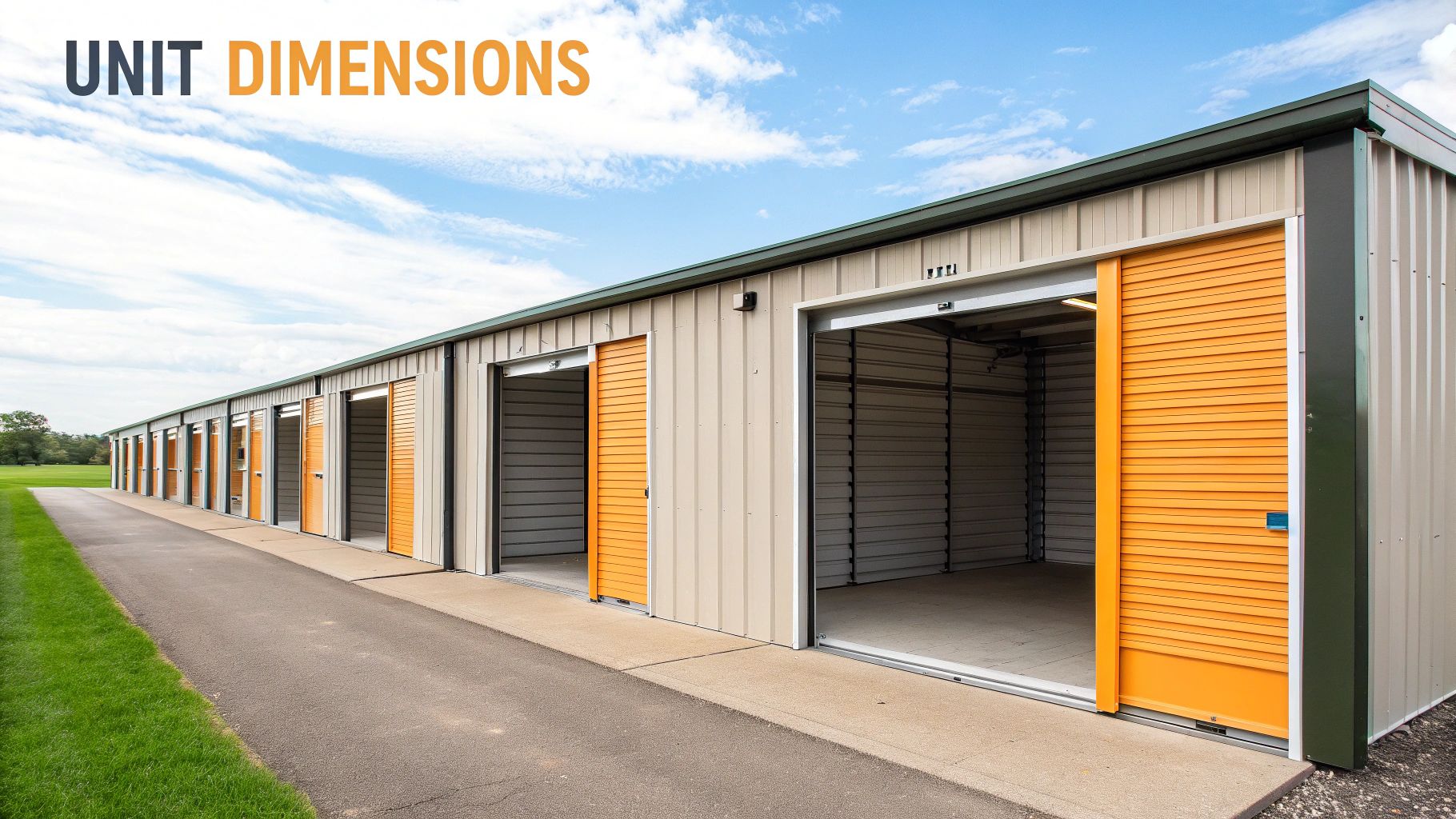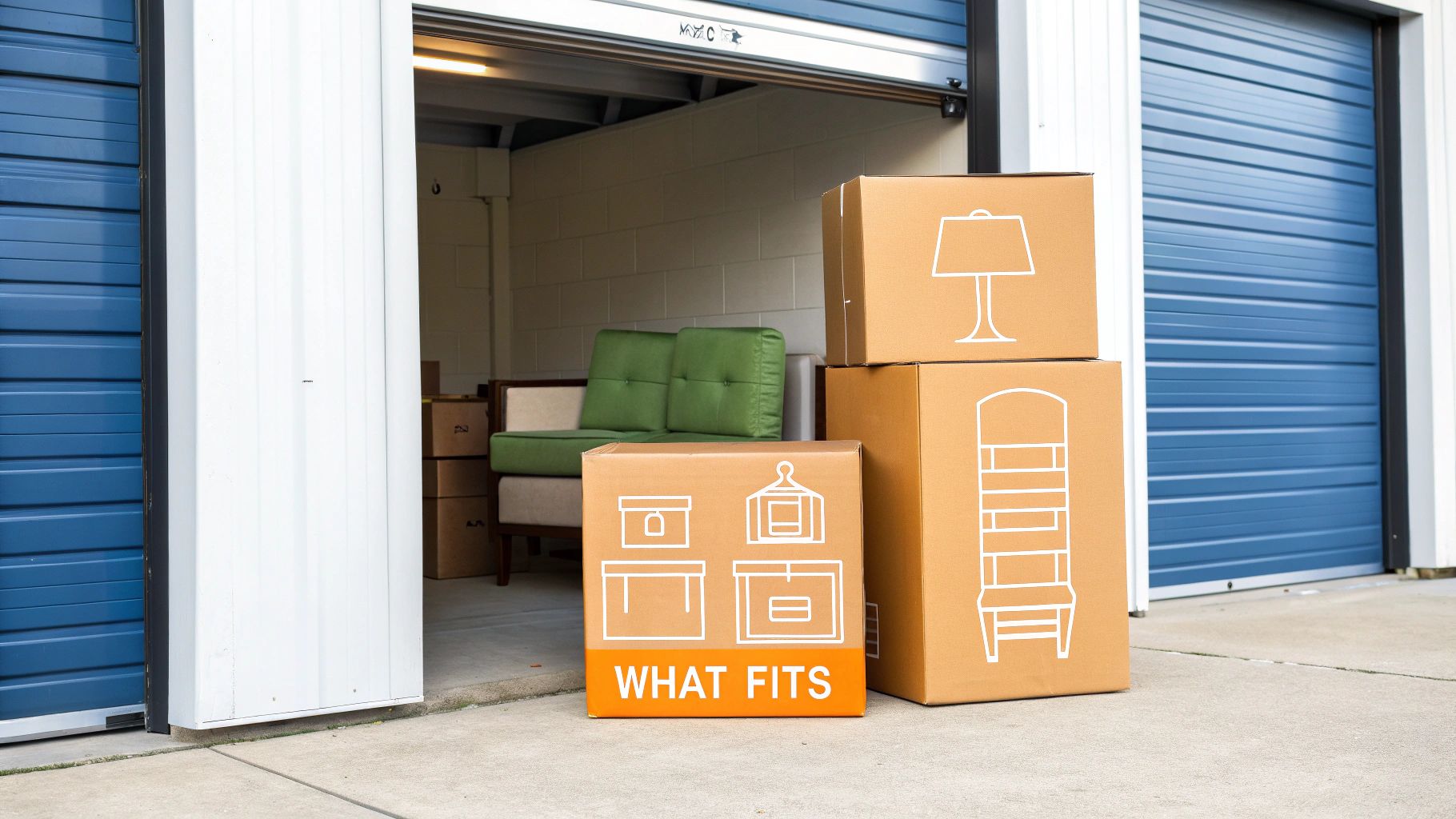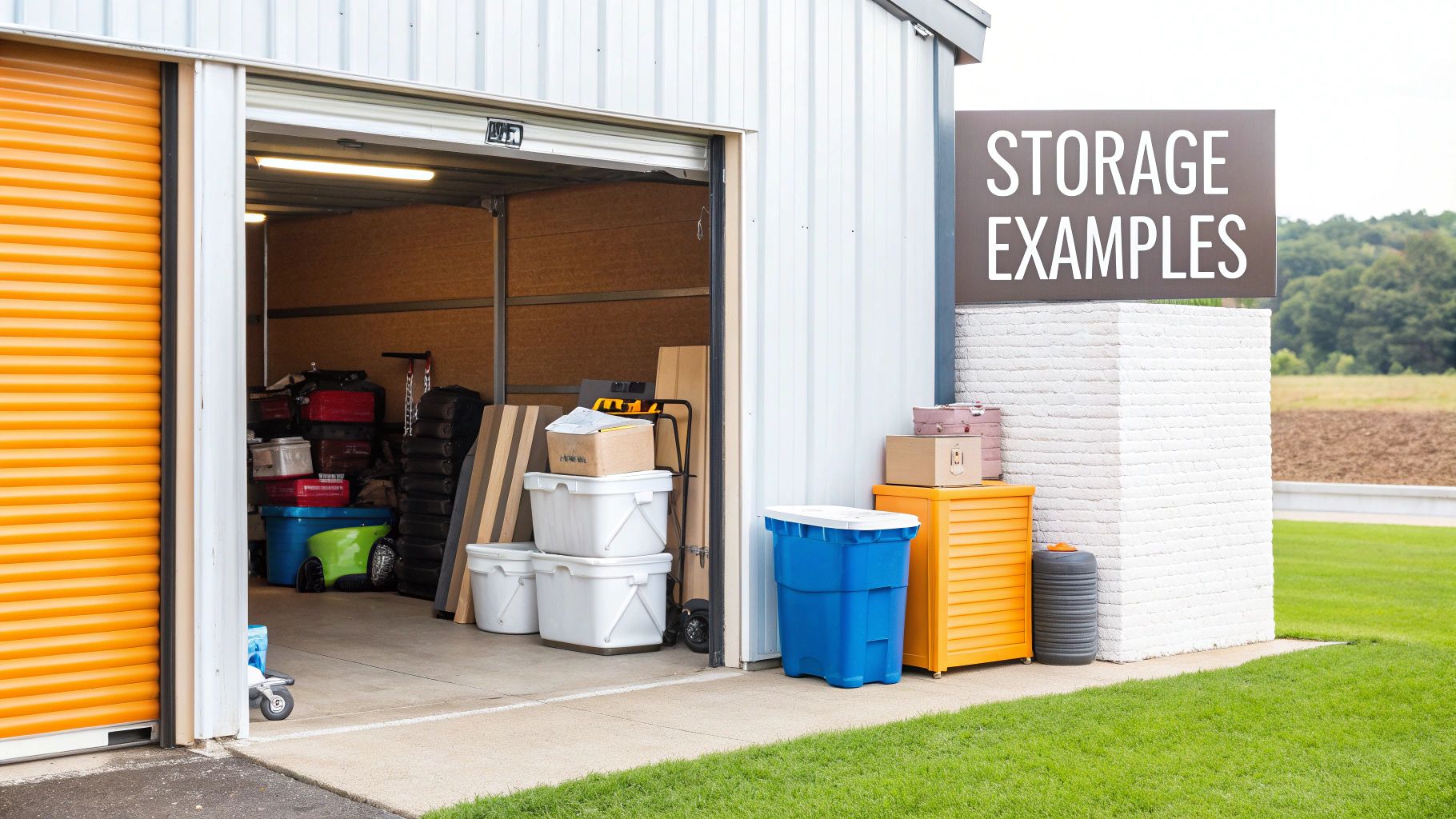Picking the right self storage unit shouldn't be a guessing game. The best way to get it right is to compare the unit sizes to spaces you're already familiar with. For example, think of a small 5×5 unit as a large wardrobe, while a bigger 10×15 unit is more like a single-car garage. When you can visualise your things in a space you know, making the right choice becomes much easier.
Find Your Fit with Our Quick Storage Size Guide
It's easy to get lost in numbers like "50 square feet" or "150 square feet," but what do those figures actually mean for your belongings? The trick is to translate these measurements into real-world equivalents you can instantly picture in your head.
Before you get bogged down in specifics, it helps to see what's out there. Exploring different private storage options with a wide range of sizes, which can range from tiny lockers to huge 55,000 sq ft commercial spaces, gives you a great sense of the possibilities. The goal isn't just to find a space, but to find the right amount of space. This way, you avoid overpaying for a unit that's half-empty or, even worse, underestimating and running out of room halfway through loading.
A Visual Comparison of Storage Units
To make things even clearer, we’ve put together a visual guide that shows how the most popular starter sizes stack up. It’s a simple way to see exactly what you’re getting for your money.
As you can see, doubling the square footage from 50 to 100 sq ft literally doubles the number of standard moving boxes you can fit inside. It’s a straightforward trade-off: more space, more capacity.
Quick Reference Storage Unit Size Chart
To help you narrow down your options at a glance, we've created a straightforward reference chart. It breaks down the most common unit sizes, what they can typically hold, and what they compare to in a standard home.
| Unit Size (Sq Ft) | Typical Dimensions (Ft) | What It Holds (Examples) | Equivalent To |
|---|---|---|---|
| 25 sq ft | 5 x 5 | Seasonal decor, small furniture, several boxes, sports gear | A large walk-in wardrobe |
| 50 sq ft | 5 x 10 | Studio flat contents, queen bed, dresser, TV, boxes | A large garden shed |
| 100 sq ft | 10 x 10 | One-bedroom flat contents, major appliances, sofa | Half of a single-car garage |
| 150 sq ft | 10 x 15 | Two-bedroom house contents, large furniture, patio items | A standard single-car garage |
| 200+ sq ft | 10 x 20 | Three-bedroom house contents, vehicles, business inventory | An oversized single-car garage |
Ultimately, don't just focus on the square footage number. Use the room equivalent—like a 'walk-in wardrobe' or 'small garage'—to create a mental picture of the space. It’s the most reliable way to gauge if a unit will truly work for you.
What Do Storage Unit Sizes Actually Look Like?
Trying to pick a storage unit based on numbers like "50 sq ft" can feel a bit like guessing. Is that big? Is it small? It's hard to know what those figures mean in the real world. This guide is here to help you ditch the abstract numbers and actually picture your belongings inside each common unit size, using simple comparisons you already get.
Getting a clear mental picture is the secret to choosing the right unit. It helps you avoid the headache of renting a space that’s too small or paying for one that’s way too big. We’ll break down the most popular sizes by comparing them to familiar spaces like walk-in wardrobes, garden sheds, and single-car garages to make your decision feel natural.
The Compact Choice: A 25 Sq Ft Unit
Think about the size of a roomy walk-in wardrobe or a small garden shed. That's pretty much what you get with a 25 sq ft storage unit, which usually measures about 5ft by 5ft. It’s the go-to solution when you just need a little bit of extra room without committing to a massive space.
This size is a real favourite among students who need somewhere to stash their uni room contents over the summer holidays. It's also perfect for homeowners looking to declutter a single room or pack away seasonal gear that's hogging valuable space at home.
So, what can you actually get in there?
- Several dozen standard moving boxes if you stack them smartly.
- Seasonal bits and bobs like Christmas decorations, winter coats, or gardening equipment.
- A few small furniture items, like a bedside table, a desk chair, or a small bookcase.
- Sporting gear such as skis, golf clubs, or camping equipment.
Basically, treat it like the ultimate overflow closet. It won't handle large furniture, but it's brilliant for holding the contents of a car boot or everything you'd typically cram into a loft.
The Versatile Mid-Range: A 75 Sq Ft Unit
Let's scale things up. Now, imagine a space that feels like a large garden shed or a small box room. That’s a 75 sq ft unit. Often measuring around 7.5ft by 10ft, it offers a serious jump in capacity and flexibility. This is where you can start thinking about storing the entire contents of a room.
It's one of the most common choices for people moving out of a one-bedroom flat. It can comfortably hold all the furniture essentials while still leaving you enough room to get around without having to empty the whole unit just to find something at the back.
Key Insight: A 75 sq ft unit really hits the sweet spot for many big life events, like moving out of your first home or doing a bit of renovating. It gives you enough room for your main furniture without the price tag of a much larger unit.
For instance, a 75 sq ft unit can typically fit:
- A king-size mattress and bed frame.
- A sofa and a couple of armchairs.
- A small dining table with chairs.
- A chest of drawers, a TV stand, and plenty of boxes.
It's the perfect option when you need to clear out a decent chunk of your home but don't quite have enough stuff to fill a space meant for a multi-bedroom house.
The Family-Sized Solution: A 150 Sq Ft Unit
When you need some serious space, the 150 sq ft unit is your answer. Just picture a standard single-car garage—that’s the kind of room you’re playing with here. With typical dimensions of 10ft by 15ft, this unit is built to handle the belongings from a two or three-bedroom house.
This size is ideal for families in the middle of a house move, undergoing major home renovations, or even combining two households' worth of stuff. It can hold bulky furniture, large appliances, and outdoor equipment all in one go. The demand for this kind of flexible space is growing across the UK. The self storage industry now has an annual turnover of around £1.2 billion, partly because of the varied needs of families and small businesses. In fact, container storage makes up about 1,135 of the 2,915 storage sites in the UK, which shows a real need for accessible, garage-style units. To find out more, you can read the full report on UK self storage trends.
A 150 sq ft unit has enough room for:
- Large sofas and sectional couches.
- Major kitchen appliances like a fridge-freezer or washing machine.
- Multiple beds, wardrobes, and chests of drawers.
- Patio furniture, a barbecue, and bicycles.
- Dozens upon dozens of boxes, with space left over to create an aisle for access.
Choosing this size means you won’t have to play a frustrating game of Tetris with your most treasured possessions. It gives you the breathing room you need for a smooth, stress-free storage experience. Hopefully, by comparing these units to spaces you already know, this guide helps you feel confident in picking the perfect size for you.
How to Calculate the Storage Space You Really Need
Visualising units as wardrobes or garages is a decent starting point, but if you want to choose with real confidence, you need a better method. A few simple calculations can save you from guessing and ensure you rent the perfect amount of space—no more, no less. It’s all about creating a quick inventory and understanding the crucial difference between floor space and total volume.
This practical, step-by-step approach takes the guesswork out of the equation. We’ll walk you through making a list, thinking vertically to get the most out of your unit, and even mapping out the space in your own home to get a genuine feel for the dimensions before you commit.
Step 1: Create a Quick Inventory
First things first: grab a notepad or open a spreadsheet and do a walkthrough of your home. List every single item you plan on storing. Don't be vague—instead of "furniture," write down "three-seater sofa," "king-size bed frame," and "dining table with six chairs."
Next to each of the big items, jot down its rough dimensions (length, width, and height). For all the smaller stuff, group them together and estimate how many boxes they’ll fill. A good rule of thumb is to assume a standard moving box is about 2 cubic feet.
Your list might end up looking something like this:
- Living Room: One sofa (2m x 1m), one armchair (1m x 1m), one coffee table, plus an estimated 8 boxes of books and décor.
- Bedroom: One double bed (dismantled), one wardrobe (dismantled), one chest of drawers, plus an estimated 12 boxes of clothes and personal items.
- Kitchen: Fridge-freezer, microwave, and around 10 boxes of cookware and utensils.
This simple list is the foundation for everything that follows. It transforms a vague pile of belongings into clear data you can actually work with.
Step 2: Think in Cubic Feet, Not Just Square Feet
This is the bit where a lot of people go wrong. A unit’s size, like 100 sq ft, only describes the floor area. But most storage units have ceilings around 8 feet high, giving you a massive amount of vertical space to play with. Thinking in cubic feet (length x width x height) reveals the true capacity you're working with.
Pro Tip: The secret to fitting more into a smaller, cheaper unit is maximising that vertical space. Stacking sturdy boxes, standing sofas on their end (with protection!), and using shelving can literally double your usable storage area.
Think about it: a 10×10 ft unit gives you 100 square feet of floor space. But with an 8-foot ceiling, its total volume is a whopping 800 cubic feet (10 x 10 x 8). That’s a huge amount of potential storage if you pack smart. By stacking boxes high and dismantling furniture, you tap into all that hidden volume.
Step 3: Map It Out with Painter's Tape
Now for a handy trick to make it all feel real. Once you have a potential unit size in mind, say a 5×10 ft space, grab some painter's tape. Mark out those exact dimensions on the floor of your largest room or garage. This simple act turns abstract numbers into a tangible space you can see and walk around in.
With your taped-off area ready, start moving the items from your inventory list into your makeshift "unit." You don’t have to shift everything, but placing your biggest pieces of furniture inside the tape will instantly show you how much floor space they really take up.
This hands-on method helps you answer some crucial questions:
- Will my sofa actually fit? Most units have roll-up doors, but it’s great to visualise the fit.
- Is there enough room to create an aisle? Leaving a path is vital if you need to access items regularly.
- Does it feel smaller or larger than I expected? This tactile experience is often the final piece of the puzzle.
By taking these few extra steps, you move from a rough estimate to total certainty. You’ll know precisely what size you need, avoiding the costly mistake of picking a unit that’s too small or paying for space you’ll never even use. This kind of planning is at the core of any good self storage size guide.
Matching Your Storage Unit to Your Life Event
Choosing a storage unit is rarely just about the items themselves. It’s almost always about the life event that’s making you need that extra space in the first place. Big transitions, whether it's moving house, starting university, or finally getting that home renovation underway, each bring their own unique storage challenges.
Figuring out this connection is the key to picking a unit that feels just right, rather than taking a wild guess and hoping for the best.
This way, you can see storage not just as a box, but as a flexible tool that adapts to whatever life throws at you. Whether you’re a student who just needs a small locker for the summer holidays or a growing family making space for builders, there’s a size perfectly suited to your situation.
For Students and Temporary Needs
University life is a cycle of moving between halls, student housing, and your family home. Every summer, the thought of lugging all your stuff back and forth is enough to make anyone groan. That’s where a small, efficient unit becomes an absolute lifesaver.
A 25 sq ft unit is usually the perfect fit. Think of it as a spacious walk-in wardrobe. It’s got enough room to securely store a single mattress, a desk, a chair, and several boxes of books and clothes. It’s a brilliant, cost-effective way to keep everything safe and ready for the next term without cluttering up your parents' garage.
We’ve put together more specific advice on our page about self storage for students.
For Moving House or Downsizing
Moving is one of the biggest reasons people turn to us for self storage. A unit provides a crucial buffer zone, letting you declutter your home before viewings or store your belongings if there's an awkward gap between moving out and moving in.
The size you’ll need here depends entirely on the size of your home.
- One-Bedroom Flat: A 75-100 sq ft unit is usually spot on. This can comfortably hold the essentials like a sofa, a double bed, a dining set, and major appliances like a washing machine.
- Two or Three-Bedroom House: You should start looking at units around 150 sq ft. This size is roughly equivalent to a single garage and can handle bulky furniture, multiple beds, and dozens of boxes with ease.
- Downsizing: If you’re downsizing, figuring out what to keep and what to store can feel overwhelming. A solid guide can make all the difference. For anyone navigating this transition, resources like this Downsizing and Moving: A Practical Guide offer some fantastic insights.
A little pro tip when moving: always choose a slightly larger unit than you think you need. It gives you room to create an aisle, which is a lifesaver when you inevitably need to grab something you packed away at the back.
For Home Renovations and Projects
Home renovations are a special kind of organised chaos. A storage unit is the best way to protect your furniture from dust, paint, and accidental damage. It also clears the decks so your builders can work more efficiently without tripping over your sofa.
For a single-room renovation, like a kitchen or bathroom, a 50 sq ft unit might be all you need to hold appliances and cabinets. If you’re tackling a larger project across multiple rooms, a 100-150 sq ft unit is a much safer bet. This ensures everything from your living room furniture to your bedroom wardrobes can be kept out of harm's way.
Key Takeaway: Match the unit size to the scope of your project. Storing items from one room requires a lot less space than clearing out an entire floor of your house.
For Business and Commercial Use
Businesses often need flexible storage for reasons that can change with the seasons. Stock, documents, tools—you name it, there’s a storage solution for it.
- Inventory Storage: An e-commerce business might start with a 50 sq ft unit for stock, scaling up to 100 sq ft or more during peak seasons like Christmas.
- Document Archiving: For physical files, a compact 25 sq ft unit fitted with shelving can securely hold hundreds of archive boxes.
- Tools and Equipment: Tradespeople often use 75-100 sq ft units as a secure lock-up for valuable tools and materials. It offers far better security than leaving everything in a van overnight.
Life events are the real reason people need storage. We’ve put together a quick table to help you visualise what size might work for your situation.
Storage Recommendations for Common Life Events
| Scenario | Recommended Unit Size (Sq Ft) | Common Items to Store |
|---|---|---|
| Student Summer Storage | 25 sq ft | Single mattress, desk, chair, boxes of books, personal items. |
| Moving a 1-Bed Flat | 75-100 sq ft | Sofa, double bed, dining set, white goods, boxes. |
| Renovating a Kitchen | 50 sq ft | Kitchen cabinets, appliances, dining furniture, tools. |
| E-Commerce Inventory | 50-100 sq ft | Product stock, packing materials, seasonal overstock. |
| Moving a 3-Bed House | 150 sq ft | Contents of multiple rooms, bulky furniture, garden tools, dozens of boxes. |
By linking your storage choice directly to the life event you’re navigating, you can make a confident, practical decision. This approach ensures you only pay for the space you truly need, for exactly as long as you need it.
Expert Tips for Maximising Your Storage Space
Picking the right size unit is a great start, but knowing how to pack it is where you really get your money's worth. A smartly organised unit doesn't just fit more of your stuff; it makes finding things later on a whole lot easier. These strategies from the pros will help you turn that empty space into a perfectly arranged storage solution.
The secret to smart packing often starts with consistency. It might seem like a small detail, but using sturdy, high-quality moving boxes of the same size is a total game-changer. Uniform boxes stack together like bricks, creating stable towers that let you safely use every inch of vertical height.
Plan Your Layout Like a Pro
Before you even think about moving anything inside, take a moment to plan your layout. The golden rule is to create a central aisle that runs from the door all the way to the back wall. Think of this walkway as your lifeline—it gives you access to everything without the painful task of unloading the entire unit just to find one box.
Your largest and heaviest items, like appliances and bulky furniture, should go in first, placed along the back and side walls. This creates a solid base for everything else and keeps the unit well-balanced.
Key Strategy: Always keep the things you'll need most often near the front of the unit. This could be seasonal clothing, important documents, or your toolkit. This one simple step can save you hours of digging around down the line.
Master the Art of Smart Packing
Packing well is about more than just filling boxes. It’s about being strategic to save space and keep your possessions safe. For a complete walkthrough, check out our detailed article on how to pack your storage unit a step-by-step guide.
Here are a few essential tips to get you started:
- Dismantle Everything: Take apart bed frames, tables, and bookcases. This massively reduces their footprint and makes them much easier to carry and arrange inside the unit. Just be sure to keep all the screws and small parts in a labelled bag taped securely to the main piece.
- Fill Empty Spaces: Don't let the space inside wardrobes, chests of drawers, or even appliances go to waste. Pack them with smaller items like cushions, linens, or books to make the most of every last bit of room.
- Label with Detail: Don't just scrawl "Kitchen" on the side of a box. Get specific: "Kitchen – Pots and Pans," or "Bedroom – Winter Jumpers." Make sure to label each box on at least two sides so you can see what’s inside, no matter how it's stacked.
Use Your Vertical Space and Create a Map
Your unit’s height is one of its biggest assets, so don't let it go to waste. If you’re storing for the long haul, think about bringing in some freestanding shelving units. Metal racking is perfect for organising boxes, stopping them from getting crushed, and keeping your belongings off the floor.
Finally, one of the simplest yet most effective tricks is to create a map. Before you lock up, sketch a quick diagram of your unit's layout on a piece of paper or on your phone. Jot down where the big items and different categories of boxes are.
That way, when you come back in six months looking for your camping gear, you won’t have to rely on memory. A simple map, combined with clear labelling, turns what could be a frustrating treasure hunt into a quick and easy visit.
Common Mistakes to Avoid When Choosing Storage
Learning from the mistakes of others is the fastest way to make a smart storage decision. It’s easy to think choosing a unit is just about finding the cheapest price, but it’s really about finding the best value for your specific needs. By knowing the common pitfalls, you can sidestep costly errors and find a solution you won't regret later on.
The single biggest mistake people make is underestimating how much space they actually need. It's one thing to see your belongings spread out across different rooms at home, but it's another to picture them packed tightly together. This classic misjudgement often leads to a stressful, last-minute scramble to upgrade on moving day. Or worse, you might try to dangerously overstuff a unit, risking damage to your prized possessions.
The Pitfall of Paying for Empty Space
On the flip side, overestimating can be just as rough on your wallet. While a little bit of wiggle room is always a good idea, renting a unit that's far too large means you're literally paying for empty air every single month. This is a common slip-up for first-time renters who, fearing they'll run out of room, default to a much larger and more expensive option than necessary.
Thankfully, with the UK self storage market expanding, there are more options than ever before. The total available space recently grew by 7.2% to roughly 64.3 million square feet across the country, so there's no need to rush into a decision. Taking a moment to properly calculate what you need means you can find a perfectly sized unit. You can see more data on UK self storage industry growth from Cushman & Wakefield.
Overlooking Crucial Details
Getting the size wrong is a big one, but several other missteps can cause major headaches down the line. It's vital to think about the entire storage experience, not just the square footage on paper.
Here are a few frequent errors to watch out for:
- Forgetting Vertical Height: So many people only consider the floor plan. Most storage units have high ceilings, offering a massive amount of vertical stacking space. Forgetting this can easily lead you to rent a much larger unit than you actually require.
- Ignoring Access Needs: If you plan on grabbing items regularly, you need to leave an aisle. Squeezing every last thing in without a walkway means you'll have to unload the entire unit just to find that one box tucked away at the back.
- Choosing on Price Alone: That suspiciously cheap unit might be a red flag. It could be lacking essential features like 24/7 CCTV, secure perimeter fencing, or even proper lighting. When it comes to your valuables, prioritising security is non-negotiable. For more guidance, check out our 10 tips for choosing a self storage facility.
Key Takeaway: A successful storage experience comes down to balancing size, cost, and facility features. Don't let a single factor, like a low price, overshadow critical elements like security and accessibility.
Still Have Questions About Storage Sizes?
Even after going through a detailed guide, it’s natural to have a few last-minute questions. Think of this section as a quick chat to clear up any lingering doubts, so you can book your unit with total confidence.
What’s the Most Popular Storage Unit Size?
Hands down, it’s the 10×10 ft (100 sq ft) unit. It seems to be the sweet spot for so many people because it’s incredibly versatile.
This size comfortably holds the contents of a one or two-bedroom flat, making it the perfect middle-ground option for common situations like moving house or tackling a major decluttering project.
Should I Get a Slightly Larger Unit Than I Think I Need?
Yes, it’s a very smart move. We almost always recommend sizing up just a little if you’re on the fence.
Opting for a unit that’s slightly bigger than your initial estimate gives you crucial space to create an aisle. This simple trick makes it much easier to access items at the back without having to play Tetris every time you visit. It also prevents you from over-packing the space, which can lead to damaged belongings.
Can I Store a Car in a Self Storage Unit?
Absolutely, but you'll need a specific size to do it right. A 10×20 ft (200 sq ft) unit is the standard minimum for storing most cars, vans, or small lorries.
It's always a good idea to check with the facility beforehand to confirm they permit vehicle storage. Be sure to ask about any specific rules or requirements they may have, as policies can vary.
Ready to find your perfect fit? Standby Self Storage offers secure, flexible units in a wide range of sizes. Book your unit online today and move in whenever you're ready.

